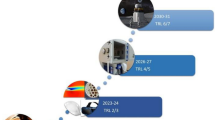Abstract
The InSight Mars Lander is equipped with an Instrument Deployment System (IDS) and science payload with accompanying auxiliary peripherals mounted on the Lander. The InSight science payload includes a seismometer (SEIS) and Wind and Thermal Shield (WTS), heat flow probe (Heat Flow and Physical Properties Package, HP3) and a precision tracking system (RISE) to measure the size and state of the core, mantle and crust of Mars. The InSight flight system is a close copy of the Mars Phoenix Lander and comprises a Lander, cruise stage, heatshield and backshell. The IDS comprises an Instrument Deployment Arm (IDA), scoop, five finger “claw” grapple, motor controller, arm-mounted Instrument Deployment Camera (IDC), lander-mounted Instrument Context Camera (ICC), and control software. IDS is responsible for the first precision robotic instrument placement and release of SEIS and HP3 on a planetary surface that will enable scientists to perform the first comprehensive surface-based geophysical investigation of Mars’ interior structure. This paper describes the design and operations of the Instrument Deployment Systems (IDS), a critical subsystem of the InSight Mars Lander necessary to achieve the primary scientific goals of the mission including robotic arm geology and physical properties (soil mechanics) investigations at the Landing site. In addition, we present test results of flight IDS Verification and Validation activities including thermal characterization and InSight 2017 Assembly, Test, and Launch Operations (ATLO), Deployment Scenario Test at Lockheed Martin, Denver, where all the flight payloads were successfully deployed with a balloon gravity offload fixture to compensate for Mars to Earth gravity.





















Similar content being viewed by others
References
H. Abarca et al., Image and data processing for InSight lander operations and science. Space Sci. Rev. (2018, this issue)
W.B. Banerdt et al., The InSight mission. Space Sci. Rev. (2018, this issue)
R.G. Bonitz, T.T. Nguyen, W.S. Kim, The Mars Surveyor ’01 Rover and Robotic Arm, in IEEE Aerospace Conference, Proceedings (Cat. No. 00TH8484), vol. 7 (2000), pp. 235–246
R.G. Bonitz et al., NASA Mars 2007 Phoenix lander robotic arm and icy soil acquisition device. J. Geophys. Res. 113, E00A01 (2008). https://doi.org/10.1029/2007JE003030
W. Folkner et al., The rotation and interior structure experiment on the InSight mission to Mars. Space Sci. Rev. (2018 this issue). https://doi.org/10.1007/s11214-018-0530-5.
M. Golombek et al., Geology and physical properties investigations by the InSight lander. Space Sci. Rev. (2018, this issue). https://doi.org/10.1007/s11214-018-0512-7
P. Lognonné et al., SEIS, SEIS: the seismic experiment for internal structure of InSight. Space Sci. Rev. (2018, this issue)
J.N. Maki et al., The Mars InSight lander cameras. Space Sci. Rev. (2018, this issue)
E. Olson, AprilTag: a robust and flexible visual fiducial system, in Proceedings of the IEEE International Conference on Robotics and Automation (ICRA) (IEEE, Los Alamitos, 2011), pp. 3400–3407
A. Spiga et al., Atmospheric science with InSight. Space Sci. Rev. (2018, this issue)
T. Spohn, M. Grott et al., The heat flow and physical properties package (HP3) for the InSight mission. Space Sci. Rev. (2018 this issue). https://doi.org/10.1007/s11214-018-0531-4.
A. Trebi-Ollennu, A.L. Rankin, C. Yang, K.S. Tso, R.G. Deen, H. Aghazarian, E.A. Kulczycki, R.G. Bonitz, L. Alkalai, Instrument deployment testbed: for planetary surface geophysical exploration, in Aerospace Conference, 2–9 March, 2013 (IEEE, Los Alamitos, 2013)
J. Wang, E. Olson, AprilTag 2: efficient and robust fiducial detection, in Proceedings of the International Conference on Intelligent Robots and Systems (IROS) (IEEE/RSJ, Daejeon, 2016), pp. 4193–4198
J. Yen, B. Cooper, F. Hartman, S. Maxwell, J. Wright, Sequence rehearsal and validation on surface operations of the Mars exploration rovers, in Proceedings of SpaceOps 2004, Montreal, Canada (2004)
Acknowledgements
This work was supported by the InSight Project at the Jet Propulsion Laboratory, California Institute of Technology, under a contract with the National Aeronautics and Space Administration.
© 2018 California Institute of Technology. Government sponsorship acknowledged.
Author information
Authors and Affiliations
Corresponding author
Additional information
The InSight Mission to Mars II
Edited by William B. Banerdt and Christopher T. Russell
Rights and permissions
About this article
Cite this article
Trebi-Ollennu, A., Kim, W., Ali, K. et al. InSight Mars Lander Robotics Instrument Deployment System. Space Sci Rev 214, 93 (2018). https://doi.org/10.1007/s11214-018-0520-7
Received:
Accepted:
Published:
DOI: https://doi.org/10.1007/s11214-018-0520-7




